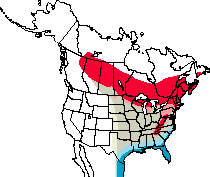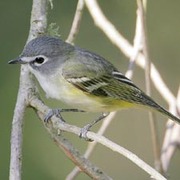Blue-headed Vireo
Vireo
solitarius
Passeriformes
Members of this diverse group make up more than half of the bird species worldwide. Most are small. However their brains are relatively large and their learning abilities are greater than those of most other birds. Passerine birds are divided into two suborders, the suboscines and the oscines. Oscines are capable of more complex song, and are considered the true songbirds. In Washington, the tyrant flycatchers are the only suboscines; the remaining 27 families are oscines.
Vireonidae
This family is found only in the New World. Vireos are small birds that move about slowly and deliberately as they glean insects from foliage and twigs. Their bills are cylindrical, with a slight hook at the end. These bills are relatively large for birds their size, which enables them to eat fairly large insects. Most vireos are drab colored, with olive-green or yellow upperparts and lighter olive or buffy underparts. Many have eye-rings, eye-lines, or wing-bars. In Washington, vireos with wing-bars have eye-rings, and those without wing-bars have eye-lines. Vireos are often hard to see as they forage in high or thick foliage, and when found are generally alone or in pairs rather than in large flocks. Most have fairly simple songs that they sing repeatedly, many singing through the entire day and even while on the nest. Nests are generally suspended from small horizontally forked branches. Pairs are monogamous, and both parents raise the young.
General Description
Two fall records, one east and one west.
North American Range Map











